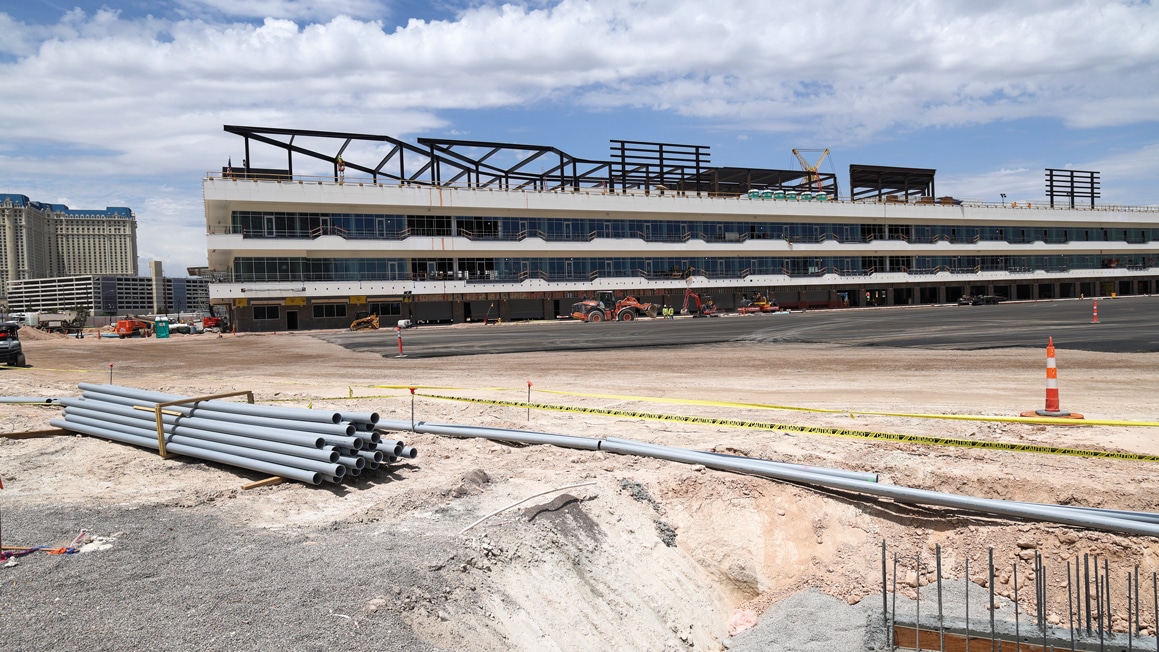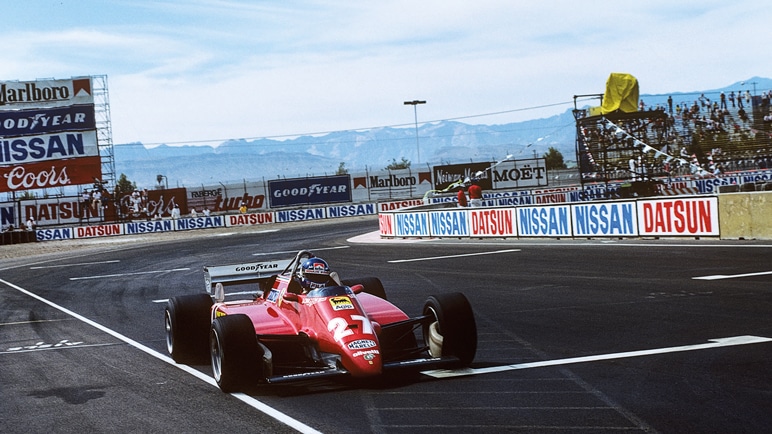Designing an F1 city circuit — the challenges facing Las Vegas GP engineers
We all love a city circuit but as Clive Bowen of Apex Circuit Design tells Damien Smith, regular roads – especially in the US – can cause plenty of problems

Construction of the Vegas track and pit complex underway in August.
Getty Images
The best street circuits require three defined sequences to offer a proper challenge for teams and drivers. So says Clive Bowen, left, founder of Apex Circuit Design that counts the Miami Grand Prix track among its many projects.
“You need something that will generate very high speed, ideally including corners as well as straights, like in Jeddah,” he explains. “But you also need the yin to the yang: a low-speed sequence, ideally one that also has gradient change so that you need compliance from a vehicle that’s not reliant on downforce. Then you need something in the middle, all to create ‘intentional mistake generators’. If you optimise your car so you gain time in the high-speed sequences you’ll lose time in the low-speed parts because you’ll have a car that’s stiff and not compliant. Likewise, vice versa.”
As a circuit designer, Bowen also targets two other key ingredients to encourage overtaking – which is never easy on street tracks. “One is the classic hairpin after a straight, a device that frankly is a push-to-pass mechanism to allow for DRS,” he says. “The other one is somewhere you can have multiple lines through a corner. Examples are the banked Turn 3 and final corner at Zandvoort, which were the idea of fghj4. The shorter route is slower in terms of vehicle speed with less aero effect, but you have the same time delta using the high line which is faster for the car but is a longer route. That is a great concept and it has been proven to work at Zandvoort. Equally, if you have a sequence where you are either accelerating through corners, or better still decelerating, the opportunity for a mistake under braking increases. We did it through Turns 6 and 7 at Miami. Some got it right, some got it wrong, so there were passes in that location.”

When devising a circuit layout, like here at Miami, what lies beneath the surface has to be considered
Getty Images
But we’re getting ahead of ourselves. When it comes to street circuits, Bowen stresses how much more complicated they are to create than permanent courses – long before he gets to consider DRS zones and the rest. “It’s about stakeholder management, understanding who’s who and how you get them on your side,” he says. “That includes the obvious: the police, the national guard or civil defence, hospitals and emergency services, the local transport authority and parkland authorities – which we had to deal a lot with when doing work on Singapore a few years ago.
“And there are a myriad of different agencies. For example, on roads some authorities are responsible for national highways in the USA and others are responsible for urban ones. So you have to identify who’s who and where they fit into the puzzle, and that’s before you even start talking to the neighbours. You might have a hotel, casino, a residential block, an office block, shops at street level. Those all need to be engaged with as individuals, their voices need to be heard, their aspirations, expectations and most importantly their buy-in needs to be secured.
“Did you ever see the film Up? You could have a little house that is not playing ball and that causes chaos with projects like this.” Although as he says, Formula 1 made life easier for itself in one key regard in Las Vegas. “Liberty Media acquired the land on which to build the pit and paddock, which I think is a masterstroke.”

Ferrari’s Patrick Tambay in qualifying at Vegas in 1982
Getty Images
As he discovered while working in Miami – both on the original site in the Biscayne Bay area and the final version around the Hard Rock Stadium – the first priority is not what’s above the ground but under it. “The subterranean world beneath the asphalt was unmapped, so we were dealing with uncharted territory,” says Bowen. “That absolutely drove our engineering. A permanent circuit is usually built on virgin ground where you can put down pipes for the drainage, immediately make sure radio signals can be picked up and once the asphalt is down cut trenches and connect and join the dots. In Miami we couldn’t do that, because we had no idea what was under the ground. So the process of excavation was also the process to build because we had to deal with thousands of cables and pipes and things that nobody knew were down there.”
“In the US it’s dry, dry, dry – and then suddenly it’s not”
Then there’s drainage. “Everything in the US is big, and that goes for rainstorms too,” says Bowen. “The same is true in Nevada as it is in Florida. It’s dry, dry, dry – and then suddenly it’s not. The drainage infrastructure has to accommodate large volumes. The Americans have a great expression for the grates that take the rainwater away. They call them ‘gulpers’.”
What about track surface? The days of simply marking out a course with concrete barriers in a Caesars Palace car park are long gone. “A modern motor racing circuit needs a billiard-smooth surface, so you must negotiate and agree a whole new engineering strategy for these roads,” says Bowen. “The other thing is the FIA require a constant fall on a road surface used for racing; they won’t allow for a crown in the middle. Imagine you have got, as you do in Vegas, a wide strip that is, say, 100ft wide. It is probably the same level on each side. But if you have F1 you need to go up or down on one side to take water off the edge, so someone is going to have to compromise on their adjacencies.”
So what does he think of the Vegas track? “I’ve only seen what you’ve seen,” says Bowen. “But I know it will work. Is it going to be a classic race track? I don’t know, but I’m not entirely sure that is important. There will be passing and the fastest car will be a Red Bull. But it will have the wow effect, people will say what an incredible event. I suspect there will be more talk about the event than the race”.
